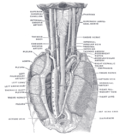| Inferior thyroid artery | |
|---|---|
 Thyrocervical trunk and its branches, including inferior thyroid artery. Superficial dissection of the right side of the neck. | |
 Human parathyroid glands | |
| Details | |
| Source | Thyrocervical trunk |
| Vein | Inferior thyroid veins |
| Supplies | Thyroid gland |
| Identifiers | |
| Latin | arteria thyreoidea inferior |
| TA98 | A12.2.08.043 |
| TA2 | 4591 |
| FMA | 10662 |
| Anatomical terminology | |
The inferior thyroid artery is an artery in the neck. It arises from the thyrocervical trunk and passes upward, in front of the vertebral artery and longus colli muscle. It then turns medially behind the carotid sheath and its contents, and also behind the sympathetic trunk, the middle cervical ganglion resting upon the vessel.
Contents
Reaching the lower border of the thyroid gland it divides into two branches, which supply the postero-inferior parts of the gland, and anastomose with the superior thyroid artery, and with the corresponding artery of the opposite side.
